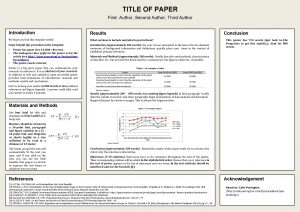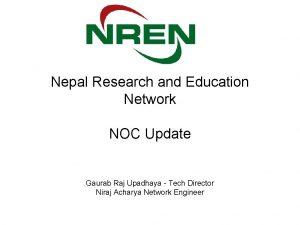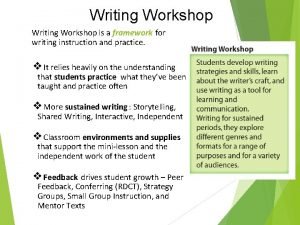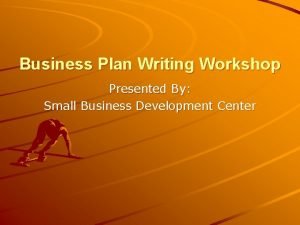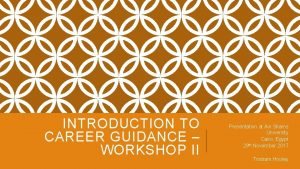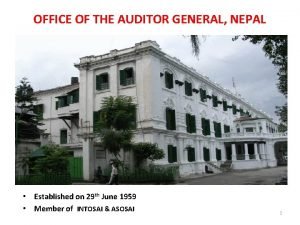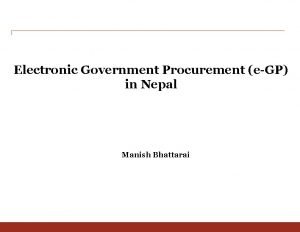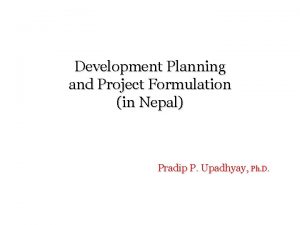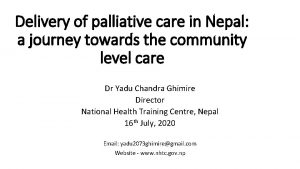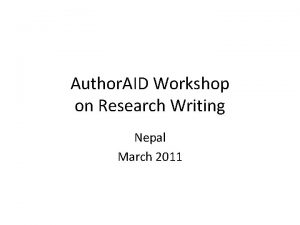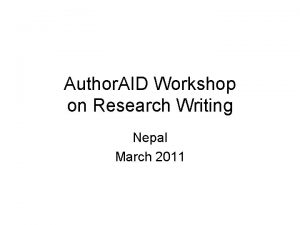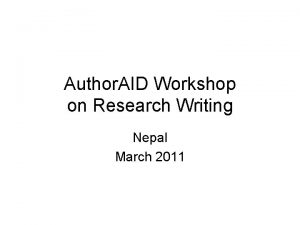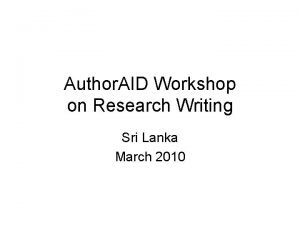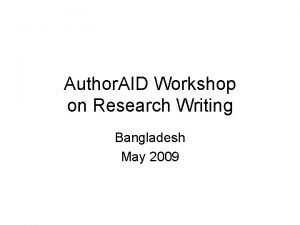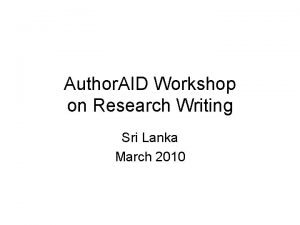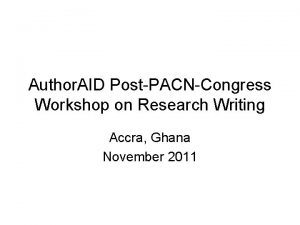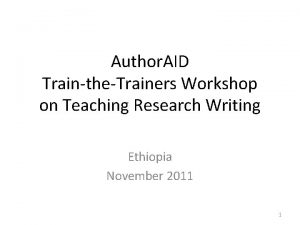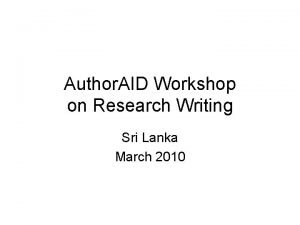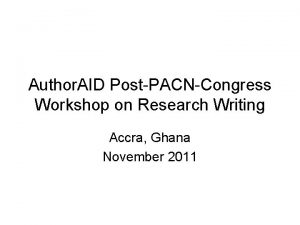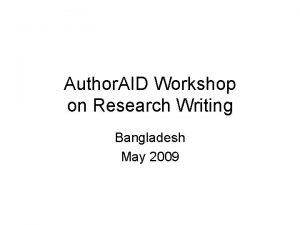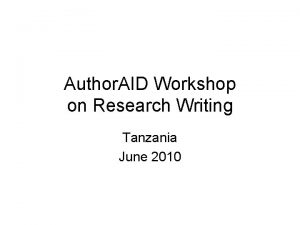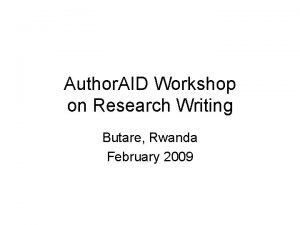Author AID Workshop on Research Writing Nepal March




























- Slides: 28

Author. AID Workshop on Research Writing Nepal March 2011

Poster Presentations and Oral Presentations Barbara Gastel, MD, MPH Texas A&M University bgastel@cvm. tamu. edu

Overview • Obtaining chances to present • Preparing and giving poster presentations – Preparing a poster – Presenting a poster • Preparing and giving oral presentations – Preparing an oral presentation – Giving an oral presentation

Background • Definitions and scope – Oral presentations – Poster presentations Example: poster winning first prize (graduate division) at a student research competition • Obtaining chances to present – Unsolicited invitations – Submission and review of abstracts

Planning a Poster • • Choose a narrow enough topic. Plan to present only highlights. Obtain and carefully follow instructions. Select images that present key messages and attract viewers. • Plan to include little text. • Plan to make the poster understandable on its own.

Organizing a Poster • Organize the poster logically (example: Introduction, Methods, Results, Conclusions). • Place the content in about 3 to 5 vertical columns. • Include plenty of white space. • In general, don’t include an abstract.

Preparing a Poster: The Title • Keep the title fairly short. • Try to make the title attention-grabbing. • Use large enough type (at least about 2. 5 cm, or 1 inch, high). • Do not use all capital letters.

Preparing a Poster: The Images • Use images (photographs, flow charts, graphs, etc) that both attract and inform. • Keep the images simple, so they can be quickly understood. • Make the images large enough. • Remember to label each image. • Use color effectively.

Preparing a Poster: The Text • Keep the text brief. • Make the type large enough to read easily. • Where feasible, use bulleted or numbered lists rather than paragraphs. • If paragraphs are used, keep them short. • Include your contact information. • Proofread the text carefully.

Brief Analysis of One or More Posters

Presenting a Poster • Don’t be shy. • Think ahead about questions you might be asked. • Perhaps ask some questions. • Take advantage of the chance for feedback. • Take advantage of the chance to network.

Presenting a Poster (cont) • Have business cards available. • Consider having handouts. • Consider having people sign up for further information. • If you’ll write a paper about the work presented, keep in mind comments and questions from the poster session.

Some Resources • “Advice on Designing Scientific Posters” by Colin Purrington (posted at http: //www. swarthmore. edu/Nat. Sci/cpurrin 1/posteradvice. htm) • “Effective Poster Presentations” (a Power. Point presentation) by Jane Tougas (posted at http: //projects. cs. dal. ca/DCSI/present. ppt)

Free Template from First Website Listed in Previous Slide

Preparing an Oral Presentation • Obtain and carefully follow instructions. • Include much less detail than in a paper to publish. • Stick to the main idea. • Give the presentation a beginning, a middle, and an end. • If feasible, structure the presentation largely as a story.

Preparing a Presentation (cont) • Remember: People must be able to understand what you say as you say it. • Minimize use of abbreviations/acronyms. • In general, prepare notes, not a full text.

Preparing Slides: Some Guidelines • • • At most one slide per minute, on average One theme or idea per slide Simple and uncrowded Thus, usually no published graphs/tables Bullet points (not paragraphs) for most text Large enough lettering to read

Compare this slide and the previous one. In general, do not average more than one slide per minute. Limit each slide to one theme or idea. Keep slides simple and uncrowded. Thus, beware of using published graphs and tables. In general, use bullet points (not paragraphs) for text. Make sure all lettering is large enough to read.

Rehearsing the Presentation • Time the presentation carefully. • Try to make the presentation slightly shorter than the allotted time. • Perhaps rehearse for others. • Perhaps have others ask you questions.

Coping with Stage Fright • Note that a little nervousness can help you perform well. • Realize that people will attend to hear the content, not to judge your speaking style. • Prepare well, but do not over-prepare. • Exercise a little. • Beware of too much food, water, or caffeine.

Coping with Stage Fright (cont) • Hide physical signs of anxiety. • Realize that a presentation need not be perfect to be excellent.

Giving the Presentation • • Arrive early. Make sure audiovisuals are working. Speak slowly enough. Speak clearly. Look at the audience. Show enthusiasm. Avoid distracting habits.

A Technique for Presenting Slides Featuring Images 1. Identify the image before showing it. 2. Draw attention to the most important part. 3. State the significance of what was shown. Source: Speaking About Science: A Manual for Creating Clear Presentations, by Scott Morgan and Barrett Whitener. Cambridge University Press, 2006.

Answering Questions • Lay the groundwork for relevant questions (for example, by stating in your talk some items that people can ask about). • Perhaps have the moderator or a colleague to ask the first question. • Briefly repeat each question. • Keep answers brief.

Answering Questions (cont) • If you don’t know an answer, say so. Perhaps – offer to find out, – suggest how to find out, or – see if someone present has the answer. • If a question seems irrelevant, offer to answer it later, or move to a related item. • If a question is hostile, answer politely and briefly; perhaps offer to talk later.

Answering Questions (cont) • Make note of questions. Use them to help shape future presentations and publications about the work.

Thank you!

Small-Group Discussion • Please discuss this afternoon’s lecture. What are the main points to remember? What questions do you have? How do you plan to use the content? • Look at some posters by group members. Note some things that are good, and suggest possible improvements. (Please keep the lectures in mind. ) • Prepare a brief talk (5 to 10 minutes) presenting highlights of your group’s discussion.
 First author second author third author
First author second author third author Anthem of poland
Anthem of poland Narrative quiz
Narrative quiz Noc update
Noc update First aid merit badge first aid kit
First aid merit badge first aid kit Greenhill medical centre
Greenhill medical centre Market research workshop
Market research workshop Qualitative research workshop
Qualitative research workshop Qualitative research workshop
Qualitative research workshop Chapter 13: writing workshop -- résumés
Chapter 13: writing workshop -- résumés Dbq thesis
Dbq thesis Writing workshop framework
Writing workshop framework Business plan writing workshop
Business plan writing workshop Conceptualisatio
Conceptualisatio Career guidance presentation
Career guidance presentation Proposal writing on career guidance workshop
Proposal writing on career guidance workshop Function of auditor general of nepal
Function of auditor general of nepal Zastava nepal
Zastava nepal Where is nepal
Where is nepal Let live in peace
Let live in peace Liquidity crisis in nepal
Liquidity crisis in nepal Iig nepal
Iig nepal Latihan bentuk muka bumi geografi tingkatan 1
Latihan bentuk muka bumi geografi tingkatan 1 यगत
यगत Egp nepal
Egp nepal Dove si trova il nepal
Dove si trova il nepal Plan formulation process in nepal
Plan formulation process in nepal Palliative care in nepal
Palliative care in nepal Chapter 25 section 3 nepal and bhutan
Chapter 25 section 3 nepal and bhutan
